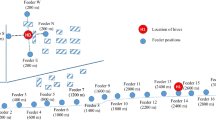Abstract
During the waggle dance of the honeybee, the dancer is able to tell her nestmates the distance and direction to a rich food source (Frisch, 1967). Little is known about how waggle dance followers are able to read the waggle dance in the darkness of a hive. Initial observations showed that not all of the bees that appear to be dance followers behave the same. Some bees maneuver themselves behind the dancer, while others do not. The paths of a single dancer, trained to an artificial food source, and her followers were traced during the waggle runs. The success of these dance followers was compared to their position relative to the dancer. The results of this study show that during a waggle run a dance follower must position itself within a 30° arc behind the dancer in order to obtain the dance information. The results suggest that bees are using the position of their own bodies to determine direction.
Similar content being viewed by others
References
Batschelet, E. (1981).Circular Statistics in Biology, Academic Press, New York.
Bozic, J., and Valentincic, T. (1991). Attendants and followers of honey bee waggle dances.J. Apicult. Res. 30: 125–131.
Esch, H., and Bastian, J. A. (1970). How do newly recruited honey bees approach a food site.Z. Vergl. Physiol. 68: 175–181.
Gould, J. L. (1975). Honey bee recruitment: The dance-language controversy.Science 189: 685–693.
Mautz, D. (1971). Der kommunikationseffekt der Schwänzeltänze beiApis Mellifica carnica (Pollm.).Z. Vergl. Physiol. 72: 197–220.
Michelsen A., Towne, W. F., Kirchner, W. H., and Kryger, P. (1987). The acoustic near field of a dancing honeybee.J. Comp. Physiol. A 161: 633–643.
Seeley, T. D. (1989). Social foraging in honey bees: How nectar foragers assess their colony's nutritional status.Behav. Ecol. Sociobiol. 24: 181–199.
Seeley, T. D., and Towne, W. F. (1992). Tactics of dance choice in honey bees: Do foragers compare dances?Behav. Ecol. Sociobiol. 30: 59–69.
Seeley, T. D., Camazine, S., and Sneyd, J. (1991). Collective decision-making in honey bees: How colonies choose among nectar sources.Behav. Ecol. Sociobiol. 28: 277–290.
von Frisch, K. (1967).The Dance Language and Orientation of Bees, Harvard University Press, Cambridge, MA.
Author information
Authors and Affiliations
Rights and permissions
About this article
Cite this article
Judd, T.M. The waggle dance of the honey bee: Which bees following a dancer successfully acquire the information?. J Insect Behav 8, 343–354 (1994). https://doi.org/10.1007/BF01989363
Accepted:
Issue Date:
DOI: https://doi.org/10.1007/BF01989363




